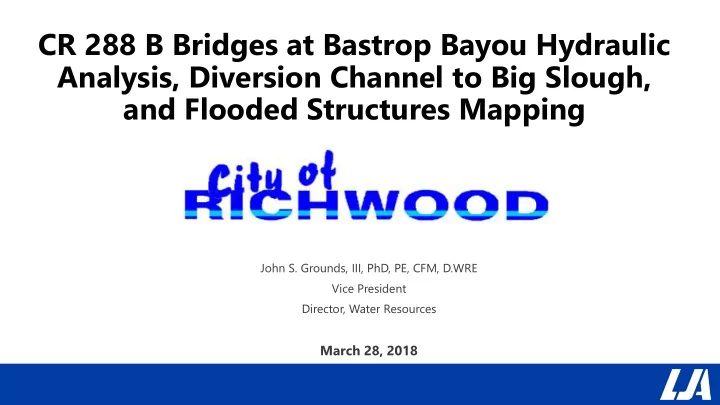

CR 288 B Bridges at Bastrop Bayou Hydraulic Analysis, Diversion Channel to Big Slough, and Flooded Structures Mapping John S. Grounds, III, PhD, PE, CFM, D.WRE Vice President Director, Water Resources March 28, 2018
Project Scope • Site Reconnaissance • Data Collection and Review • Survey • Hydraulic Modeling of CR 288 B Bridges at Bastrop Bayou • FEMA/TxDOT/Updated Survey • Pump Capacity Determination • Diversion Channel Conceptual Design • Hydrology and Hydraulics • Channel Cross Section for 25 and 100-Year Events • Cost Estimates • Harvey Flooded Structures Map
Site Reconnaissance Bastrop Ragsdale Rosen
Survey • Surveyed approximately 2,500 LF along the upstream and downstream faces of all three bridge openings • 2 Cross Sections across Big Slough
TxDOT Angleton Area Office
FEMA Model • Confirm Flow through all three (3) bridge openings. FEMA only had the Bastrop Bayou opening modeled. • Updated HEC-RAS 5 2 D Hydraulic Model
Southern Bridge (Bastrop Bayou) Cross Section Comparison: Bastrop Bayou 20 Scour/Cut 15 10 TX DoT Plans Elevation (ft) FEMA Model 5 Survey Scour/Cut 0 0 100 200 300 400 500 600 700 800 900 -5 Siltation -10 Relative Station (ft)
Cross Section Comparison: Ragsdale Creek 16 14 12 10 Elevaton (ft) 8 6 TX DoT Plans 4 FEMA Model 2 Survey 0 0 50 100 150 200 250 300 350 400 450 -2 Relative Station (ft)
Cross Section Comparison: Rosen Creek 12 10 Elevation (ft) 8 6 TX DoT Plans 4 FEMA Model 2 Survey 0 0 50 100 150 200 250 300 350 400 450 500 -2 Relative Station (ft)
HEC-RAS 2D Updated Model Results Individual Bridge Flows Combined Peak Flows 3000 7000 Bastrop Bayou 6000 Ragsdale Creek 2500 Rosen Creek 5000 2000 4000 1500 Flow (cfs) Flow (cfs) 3000 1000 2000 500 1000 0 0 0 200 400 600 800 1000 1200 1400 0 200 400 600 800 1000 1200 1400 -500 -1000 Time (t) Time (t) Ragsdale Creek Max Flow (cfs): 2522 Rosen Creek Max Flow (cfs): 1191 Bastrop Bayou Max Flow (cfs): 2797 Combined Peak Flow (cfs): 6484
HEC-RAS 1D Updated Model Results • For the 10, 50, 100, and 500-Year Events, there is a 0.01 feet decrease in the water surface elevation when the TxDOT bridges are updated with the surveyed topography. • Updating the FEMA model with the updated survey, TxDOT bridges, and opening all 3 bridges results in a deceases as follows: • 0.07 feet for 500-Year (~12.7 Feet) • 0.03 feet for the 100-Year (~12.0 Feet) • 0.03 feet for the 50-Year(~10.9 Feet) • 0.05 for the 10-Year (~8.9 Feet) • These are all dominated by the Combined Probability (Riverine + Coastal) (100-Year / ~12 Feet) • The Flood Insurance Rate Maps would be unchanged so a Letter of Map Revision is NOT needed.
HEC-RAS 1D Updated FEMA Model Conclusions • Siltation in channel is offset by wider cross section in overbanks. • FEMA vs. TxDOT vs. Survey results in no significant difference in Water Surface Elevations for 10, 50, 100, and 500-Year Events • Pumping is not needed to offset the loss in conveyance from siltation. It would increase flooding potential downstream.
Diversion Channel to Big Slough: 25-Year Capacity Layout • 360 CFS Capacity • 4 Feet Deep • 4:1 SS (H:V) • 65 Foot Bottom • 30’ Maintenance Berms • 158 Feet ROW • 3 – 4’ x 10’ RCB Culverts • 3 – 4’ x 10’ RCB Siphon • Channel Slope = 0.018% • Channel Velocity = 1.5 FPS (SLOW)
Diversion Channel to Big Slough: 100-Year Capacity Layout • 455 CFS Capacity • 4 Feet Deep • 4:1 SS (H:V) • 85 Foot Bottom • 30’ Maintenance Berms • 178 Feet ROW • 4 – 4’ x 10’ RCB Culverts • 4 – 4’ x 10’ RCB Siphon • Channel Slope = 0.018% • Channel Velocity = 1.5 FPS (SLOW)
Diversion Channel to Big Slough: Cost Estimates
Flooded Structures Mapping • Report from the City of Richwood • Highlighted Brazoria County Appraisal District parcels
Questions, Comments, and Discussion
Recommend
More recommend